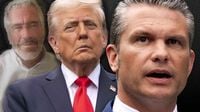On September 29, 2025, a statue depicting former President Donald Trump and convicted sex offender Jeffrey Epstein was quietly removed from the National Mall, capping a week of political turbulence and renewed scrutiny of both men’s intertwined histories. The statue’s brief appearance—alongside a swirl of related controversies—underscored just how charged the Epstein scandal remains for Trump’s circle, as well as for the broader American political landscape.
The removal of the Trump-Epstein statue was just one flashpoint in a series of events that have reignited debate about accountability, abuse of power, and the lingering shadows cast by Epstein’s crimes. According to SAN, the statue was taken down on September 29, 2025, after its installation by a group of crypto investors drew national attention and public outcry. The artwork’s presence on the National Mall—one of the country’s most symbolic spaces—was a pointed reminder of the unresolved questions surrounding Epstein’s connections to powerful figures, Trump foremost among them.
But the controversy didn’t end with the statue. That same day, a congressional candidate publicly defended controversial comments made by conservative activist Charlie Kirk, highlighting how culture-war skirmishes continue to intersect with the ongoing fallout from the Epstein affair. Just days earlier, President Trump’s own approval rating had dipped to a second-term low, a development many commentators linked to the week’s cascading scandals.
Meanwhile, in the halls of government, a more ominous drama was unfolding. As reported by WhoWhatWhy, Secretary of War Pete Hegseth summoned the top brass of the U.S. military to an unprecedented all-in-person meeting in Virginia. The timing was conspicuous: the gathering began the very day Congress debated whether to shut down the government, a move that Trump’s former Budget Director Russell Vought—an architect of the radical Project 2025—said would not only result in temporary furloughs but also in mass, permanent firings across the federal workforce. Vought’s vision, according to the outlet, was a government focused almost exclusively on “homeland protection”—borders, law enforcement, and the military—at the expense of other functions.
The meeting of generals, shrouded in secrecy, sparked speculation about its true purpose. Some observers, drawing on the 1964 political thriller Seven Days in May, wondered aloud if the U.S. was witnessing the early stages of a military purge—or even a test run for a “soft coup.” According to an anonymous source cited by WhoWhatWhy, Hegseth intended to warn the assembled officers that they needed to “row in the same direction” or risk their careers. The meeting would also outline a new Trump-era vision for national security, emphasizing the Western Hemisphere and domestic priorities over “far-flung conflicts.”
The intrigue deepened when news broke that Trump himself would attend the Virginia session. While the former president initially claimed ignorance of the meeting, his sudden involvement fueled further questions about the administration’s intentions. Was this a bid to shore up Hegseth’s standing, a strategic move to sideline dissenting generals, or simply a distraction from the mushrooming Epstein scandal? As WhoWhatWhy put it, “They’re not even trying to plausibly disguise it anymore.”
Amid this political theater, Trump announced via social media on September 27 that he was deploying troops to Portland, Oregon, to “protect immigration-related facilities supposedly ‘under siege’ by Antifa and ‘other domestic terrorists.’” Local reports, however, described the situation as a small, largely peaceful protest that had persisted for months. Critics called the move a transparent pretext for domestic militarization, with Trump’s rhetoric drawing sharp rebukes from both sides of the aisle.
Yet, even as the administration’s attention seemed to pivot toward security and spectacle, the Epstein saga refused to fade. On September 19, the House Oversight Committee conducted a closed-door deposition with Alexander Acosta, the former U.S. attorney who negotiated Epstein’s infamous 2008 plea deal. That agreement allowed Epstein to serve just 18 months in county jail—of which he served only 13—while enjoying a work release program that let him return home for 12 hours a day, six days a week. The leniency of the deal, and Acosta’s subsequent appointment as Trump’s labor secretary in 2017, have fueled years of suspicion and outrage.
During the deposition, Rep. Melanie Stansbury (D-NM) revealed that “at least 40 minors gave sworn statements to the FBI as part of the investigation that they had been raped, abused and trafficked.” Yet, as Stansbury pointed out, Acosta claimed he did not see sufficient evidence to pursue a more aggressive prosecution, but admitted he had not actually read the statements of the victims. “If Acosta did not review the evidence, how would he know ‘there were weaknesses in the case?’” Stansbury asked, voicing the frustration of many.
Rep. Dave Min (D-CA), a former SEC prosecutor and Oversight Committee member, was blunt in his assessment: “After the first hour of sitting with Alex Acosta, I found him to be completely non-credible as a witness. His answers were evasive, he obfuscated and they were just not believable.”
One of the most explosive claims about the plea deal is that Acosta was told to back off because Epstein “belonged to intelligence” and was “above his pay grade.” Acosta has denied making this claim, but journalist Vicky Ward has stood by her reporting that a senior Trump White House official confirmed the account. The intelligence angle remains a subject of ongoing investigation, with WhoWhatWhy promising further revelations.
For his part, Acosta’s attorney, Jeffrey Neiman, said, “Mr. Acosta stated that, with today’s knowledge, the 2006 prosecution would have been handled differently, as far more is known about Epstein now than nearly two decades ago.” But for many, that explanation rings hollow given the mountain of evidence already available at the time.
As the political and legal battles raged, Trump reportedly struggled to grasp why the Epstein scandal remained such a lightning rod. According to The Wall Street Journal, the president told staffers in July that he didn’t understand the public obsession and attempted to excuse Epstein’s actions by saying, “Palm Beach in the 90s was a different time.” The next day, he called friends and allies, asking why the issue wouldn’t die down and how he could make it disappear. Despite making the release of the “Epstein files” part of his 2024 campaign platform, Trump has since dismissed speculation about Epstein’s crimes as a “Democratic hoax.”
Attorney General Pam Bondi reportedly informed Trump in May that his name appeared multiple times in Epstein-related documents. Social media users were quick to mock Trump’s “different time” defense, with one commentator noting, “I was alive in the 1990s and I distinctly recall that child rape was considered really really bad.”
As pressure mounts for the Justice Department to release additional Epstein files, and as the House edges closer to a vote on the matter, the questions swirling around Trump, Epstein, and their enablers show no sign of abating. For now, the removal of a golden statue from the National Mall is only a symbol—a fleeting gesture in a saga that continues to haunt the highest echelons of American power.

